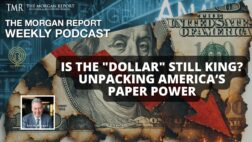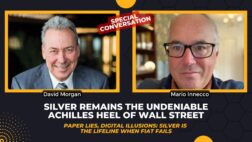China’s Central Bank Touts Gold; Exclusive Interview with David Smith.
Transcript:
Mike: It is my privilege now to be joined again by David Smith, Senior Analyst at the Morgan Report and regular contributor to MoneyMetals.com. David, welcome back. How are you today?
David: I’m very good today, Mike. How are you?
Mike: Well, David, I wanted to have you on this week because you’ve always maintained such a level headed approach to the markets, which is so important right now. First off, what’s going on in silver? Are we in a danger zone now that we’ve taken out some key support levels and fallen below the 2013 low, in the low $18 range?
David: Well, we certainly have dropped down below that $20 to $18.50 range. We’re now in the $17.50s level. From a technical standpoint, it looks kind of on a negative side but, but the thing is, silver does like to take out supposed charge support levels and then turn around. We may be down here for awhile, but the point is we’re still in a band of support that goes down quite a ways further than what we are.
Mike: What do you have to say to the precious metals investor who may be getting pretty worn out by the market action over the last 2 or 3 years?
David: It’s been difficult, for sure. We’ve been in what I believe is a cyclical bear market within the larger secular bull market. That has a tendency to either “scare people out or wear people out” as David Morgan likes to say. It’s been hard for anyone with a position. But what’s kind of interesting is the people that kind of understand this and can go against their emotion, are continuing to add to their positions, especially the physical at the price level that we’re in now.
I was just noticing yesterday the sales of American Silver Eagles has moved up sharply in the last couple of weeks. The SLV ETF continues to add silver and gold sales in Europe are picking up substantially. The people that are adding to their positions either on a dollar cost averaging basis, especially the physical, or on a monthly basis or simply when they have some extra money, still are showing a lot of support in their belief that this bull market is in a pause rather than being over.
Mike: Last I checked the fundamentals for why you want to own gold and silver in the first place have not changed. I think we’ve still got governments spending beyond their means, central banks printing lots of paper dollars out of thin air. Unless I’m missing something, I mean, is that how you’re kind of looking at things, too?
David: Definitely. I can’t think of a single thing that’s gotten better from the standpoint of the fundamentals that will drive the metals higher. What we have now is a situation of poor sentiment and that’s when a lot of people are bearish. The sentiment can override fundamentals, it can override seasonals and then it can cause things to turn around in a substantial way. The charts don’t show that too well. They can show the level of sentiment, but they can’t say just when that sentiment will change and suddenly turn in the opposite direction and cause prices to move substantially higher.
Mike: We’ve talked before about investor psychology and talking about the mindset of say the market timer, for instance. I wanted to talk to you about bitcoin depression. I’ve heard you mention that recently. What is that and how might it relate to the metals market today because I think it’s a good little example of what could happen.
David: Bitcoin, of course, as you know, is an e-currency. It’s a virtual currency. When it first came out a few years ago, you could buy bitcoins for less than a dollar. I was reading an interesting article on bitcoin depression where this individual had spent around — I think he paid around $0.40 for his bitcoins or $0.80, I guess that was it. When it got up to $4, he sold them all for about a 500% profit, which, in just about anyone’s book, would be a good profit. Then he proceeded to watch bitcoins go from the from the $4 level where he had sold because he figured that was a blow-off top, to go up to almost $1,000 an ounce. Now the bitcoins still trade around $450 an ounce. That’s a pretty hard thing to overcome if you no longer have a position.
This is what happens if you think you can outsmart the market. It will also happen if you don’t take a long enough view and you sell into rallies and then, at some point, the market goes kind of where you thought it would go or even a lot higher. But meanwhile, you’ve taken a profit on your entire position on the way up. You either no longer have a position or it’s small enough that it isn’t affected by much even if the price goes much, much higher than you had anticipated.
Mike: Relating, I guess, a similar story to the precious metals here, you and I have talked a lot about palladium in the past, going back to early last year when you accurately predicted that this lesser known metal would outperform the other PMs. Of course it’s been a bit of a roller coaster ride over the last 10 to 15 years but, it’s been a great investment at the same time but, only if you stuck with it. Despite the recent pullback, palladium is still up a fair bit for the year. What is the palladium chart telling you? Then also give us some history of what’s transpired with this metal over the last decade or so.
David: You know Mike, I didn’t fully realize just how interesting the palladium chart was until last week when I took another look at the 25-year chart. I had kind of correlated this with the anecdote that I gave in one of my talks about an individual who bought palladium in 2005 at around $170 an ounce and it was a $50 premium, so he was into it for about $220, was his net cost for physical ounce. Palladium proceeded to go to $350 and then down to $180 again and then up to $600 and down. It proceeded over the last 7 or 8 years to go up and down to his point of entry several times on a monthly basis.
You could have found places where he could have market-timed and sold some or all of his position in there but the reality is if he had followed virtually any kind of technical analysis, he would have been out of the market long before $600 an ounce and then it dropped down again. We hit $920 an ounce here just a few weeks ago and it’s now around $800. Palladium kind of puts the matter to rest that technical analysis can always predict where things are going to go because all of those bullish signals turned bearish at that point. Yet here palladium is, even with the retracement that we’ve had of about $100 an ounce, it’s still almost 4 times higher than where this individual bought. This particular person did not get out of the markets, has most of the palladium that they had purchased and is still holding on.
Indications are that over the next few years, that that price may go much, much higher than it is. I think that has something to tell us about silver, which looks kind of poor from a technical standpoint by now, but if you believe, as we do, that all of the fundamental reasons are still here for much higher price, then you kind of turn off that mental computer and just don’t look at it on a daily basis. Wait for the fundamentals and the actual sentiment on the part of the markets to turn in the direction that you feel strongly will eventually happen.
Mike: We’re in the business of buying and selling physical metal here and we’re just as happy to buy metal back from customers as we are to sell it to them. Right now, of course, we’re getting a lot more buy orders than sell orders but, every time I hear about customers that are selling big portions of their position, if not their whole position, at these levels, I just cringe a little bit. This is not the time to be selling, in my eyes anyway. I think we’re seeing a fantastic buying opportunity over the long term. I would not want be that guy that’s selling at $17-$18 silver and looking back 3-4 years from now when it’s $50+ an ounce and just kicking himself because he just couldn’t hang in there. You’ve seen that obviously a lot in your travels, haven’t you?
David: It really is true. It’s so hard to go against your emotions but your emotions tend to steer you in the wrong direction, especially at market turns. As you mentioned, that person that sells out or sells a portion, the reason one is afraid to begin adding or to add more if they have the financial wherewithal to do it, needs to go against those emotions. All the great traders, and I’ve studied it for many years, have been able to do that. They’ve been able to buy when it was very, very difficult emotionally and hold on until prices went into a much higher overpriced zone and then sell some when the sentiment was overly, overly bullish. This is really how you make and hold onto significant profits. It’s not easy to do but, it’s also not impossible. You study how the great traders have done it and then you try to emulate them in that regard.
I think, Mike, one of the things that really keeps me up in this is that in spite of all the bearish talk that I see today and the looks of the charts is that we have not had a public blow-off yet. When this happens, I believe it’s going to be a global phenomenon with the Chinese and the Indians participating, as well as the Western countries. It’s going to be really something to see because the endemic problems that we have in this country of overspending and debt creation and excess money creation, is really going on in many other areas of the world, too. Those items that lead us to believe that the supply/demand situation is getting really out of kilter for the metals, these are things that affect other countries, too. It’s not just the United States and a short few European participants like it was during the more sedate 1980 bull run in gold and silver.
Mike: Given everything we’ve seen here and where we are in the precious metals markets today, mainly silver and gold, give us your assessment of things and then what kind of risk is there right now?
David: You can put together a risk/reward scenario, and no one can predict the future, but I look at the balance of support for silver down into the $15 range and even a little below that. But, if you assume that the risk, for example, is $2.50 or $3 from in here down into that level versus where you think it’s going to go and I think a case can be made that the risk/reward is probably 1 in 7 or 1 in 10 because once silver turns around and moves back up into the low $20s again, it has that potential to go up and challenge the all-time highs around $48 or $50.
People should remember, too, that in 1980 when silver topped out at around $50, if you adjust just for inflation, even if as government reports it, which is much lower than the actual real inflation that goes on, you’re going to have a situation of anywhere from $125 to $200 an ounce in inflation adjusted dollars where silver would be today at the equivalent purchasing power as it was in 1980. I would say 1 to 7 or 1 to 10 in terms of risk/reward. I think for gold, a minimum of 1 to 4 or 1 to 6. It takes a while for these things to work themselves out, but when they really get underway, I think that’s the potential that we’re looking at.
The thing is, with people today that are not able to go against their emotions and either hold their position or add to them, and of course without margin, once prices turn around, it will be impossible to know early on whether this is just a rally, that it’s destined to turn lower once again or whether the real thing is getting going and we’re seeing the early stages of a massive bull run to the top. By the time that becomes obvious to most people, most of the profit position will be past and you will now have a much higher risk position. Instead of the 1 to 7 or 1 to 10 risk/reward we’re talking about now, it might be 3 to 2. Or even money. Those are not good odds.
It’s hard to buy now but if you buy carefully and over, whether it’s dollar cost averaging or monthly basis or as you have extra funds, then remember it’s not like you’re buying something that is going to go away. You’re buying what’s been money for thousands of years. You’re actually exchanging what David Morgan calls, “paper promises”, the currency in your wallet, for physical reality which is money that you can spend and that can be traded in at the market price of any given day, anywhere in the world, and has been the money of final resort for thousands of years.
Mike: Very well put, indeed. Patience is definitely a key virtue right now. Hopefully people can maintain that in this sort of rough environment. Well David, we appreciate your guidance at frustrating times like those that precious metal owners are experiencing right now. Thanks for coming on and we’ll catch up again with you soon.
David: You bet, Mike. It’s been enjoyable speaking with you.
That will do it for this week. Thanks again to David Smith. Check back next Friday for our next weekly market wrap podcast. Until then, this has been Mike Gleason with Money Metals Exchange, thanks for listening and have a great weekend everybody.
David Morgan is a precious metals aficionado armed with degrees in finance and economics as well as engineering, he created the Silver-Investor.com website and originated The Morgan Report, a monthly that covers economic news, overall financial health of the global economy, currency problems, and the key reasons for investing in precious metals.
As publisher of The Morgan Report, he has appeared on CNBC, Fox Business, and BNN in Canada. He has been interviewed by The Wall Street Journal, Futures Magazine, The Gold Report and numerous other publications. If there is only one thing to teach you about this silver bull market it is this… 90% of the move comes in the last 10% of the time! Where will you be when this happens?
Offer does not apply to Premium Memberships.



